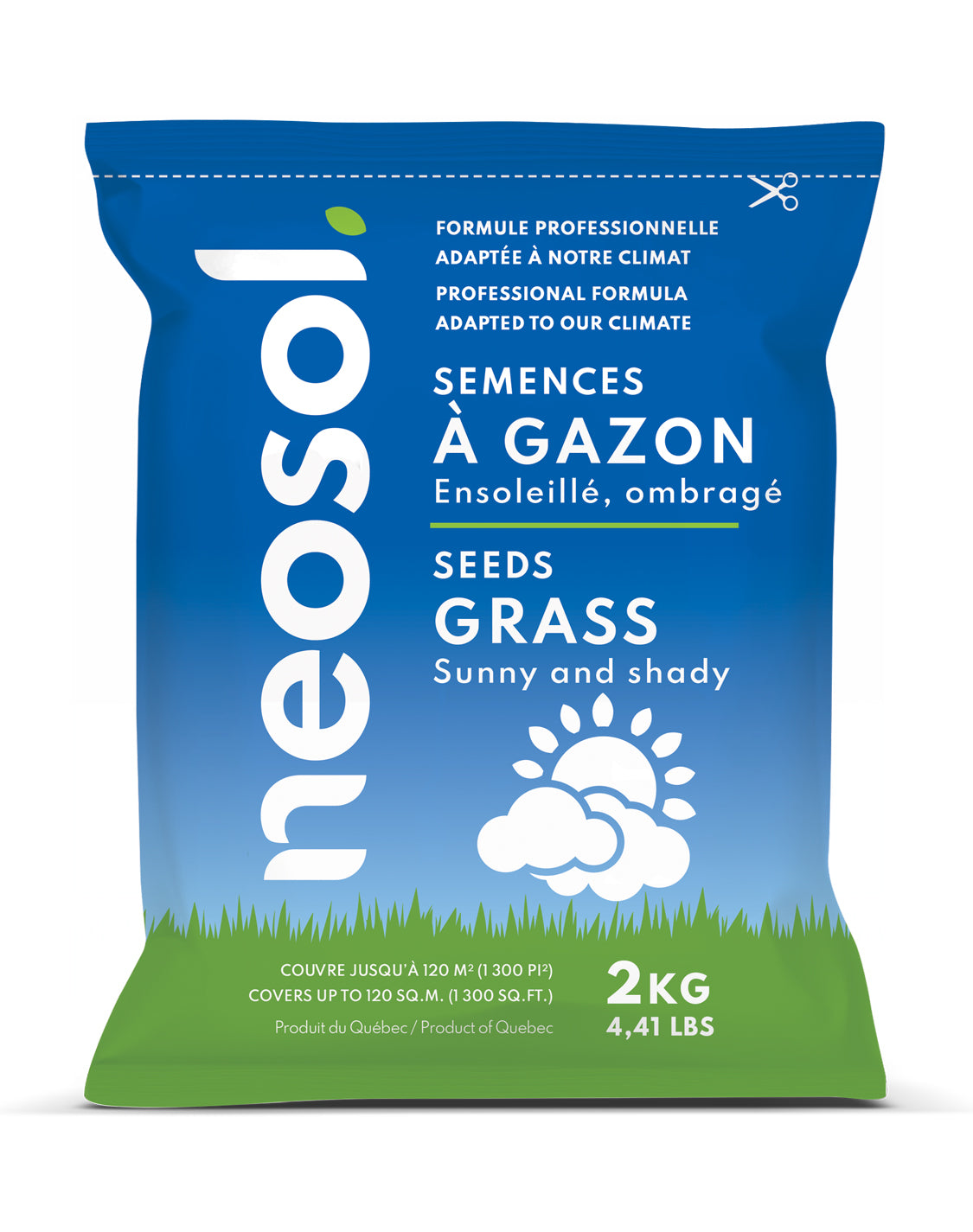Neosol Lawncare
Sun/Shade Grass Seed - 2kg
Sun/Shade Grass Seed - 2kg
Couldn't load pickup availability
 Ideal for shady areas
Ideal for shady areas
 Designed for harsh climates
Designed for harsh climates
 Canada No. 1 Certified Lawn Mix
Canada No. 1 Certified Lawn Mix
-
Perfect for very sunny or very shady locations.
-
Ideal for withstanding cold winters.
Description
Neosol Sun/Shade seed allows you to obtain a new lawn that is very resistant, no matter the location. It adapts equally well to sunny areas as well as under trees in the shade. The lawn becomes more resistant to trampling and drought and having a dense lawn allows you to have a lawn with fewer weeds. These seeds also allow the new lawn to withstand winters well. The mixture contains the best seeds in terms of quality.
Blanket
New seed coverage: 2 kg covers 75 m2 / 810 ft2
Reseeding coverage: 2 kg covers 120 m2 / 1300 ft2
Mélange
Mélange
Recipe
5% Esquire Perennial Ryegrass
15% Kentucky Bluegrass SR2100
15% Maxima creeping red fescue
10% Brahms Grass Fescue
5% Dumas 1 hard fescue
40% Starlett Tall Fescue
Utilisation
Utilisation
Repairing dead grass patches / Repairing dead grass patches
- Mow the lawn very short, about 2 in.
- Rake yellowed or damaged lawn
- Pull out as many weeds as possible
- Spread a 1/2-inch thick layer of seed compost over the entire desired surface.
- Spread the seeds evenly.
- Add a layer of potting soil about 1/4 inch over the entire surface.
- Keep the soil moist until the lawn is established (without waterlogging), for about 20 days. The spray should be gentle so as not to wash away the seeds.
- Mow the lawn when it is about 4 inches tall.
Re-seed and overseed
Reseeding helps increase the density of your lawn and reduce weed growth.
- Aerate the soil (ideally)
- Mow the lawn very short, about 5 cm (2 in)
- Pull out as many weeds as possible.
- Spread the seeds evenly, making sure they come into contact with the soil.
- Keep the soil moist until the lawn is established (without saturating it with water), for about 20 days.
Seeding a new lawn
- Clear the surface of any debris.
- Spread a 4 to 6 inch layer of potting soil over the entire surface
-Spread the seeds evenly.
-Add a layer of potting soil about 1/4 inch over the entire surface.
-Keep the soil moist until the lawn is established (without it being saturated with water), for about 20 days. The jet must be weak so as not to carry away the seeds.
-Mow the lawn when it has reached a height of approximately 4 inches.
Livraison
Livraison
Gratuite avec tout achat de 125$ et plus.
Partager


FAQ
What distinguishes sun/shade seed from other seeds?
1. Adaptability to various light conditions:
Sun and Shade: The combination of these grasses is specially formulated to thrive in both full sun and shaded areas. This makes them a versatile choice for lawns with varying amounts of sunlight throughout the day.
2. Resilience and robustness:
Esquire Perennial Ryegrass (5%): Offers rapid germination (5-10 days), allowing for rapid initial ground coverage. It also provides resistance to trampling, which is useful for high traffic areas.
Creeping Red Fescue Maxima (15%): Good shade tolerance, improves turf density and helps cover bare areas through its propagation by rhizomes.
Brahms Turf Fescue (10%): Good disease resistance, contributing to overall lawn health.
Dumas 1 Hard Fescue (5%) and Starlett Tall Fescue (40%): Excellent drought tolerance, which is essential for maintaining a green lawn in arid conditions. Tall fescue also develops a deep root system, improving the stability and durability of the lawn.
3. Resistance to environmental stress:
Kentucky Bluegrass SR2100 (15%): Provides excellent resistance to heat and water stress. It contributes to the durability and rapid recovery of the lawn after periods of stress.
4. Fast and even coverage:
Germination and Establishment: The presence of perennial ryegrass ensures rapid germination, while fescues and Kentucky bluegrass contribute to a dense and uniform cover. This combination makes for an aesthetic lawn with a pleasant texture.
5. Weed Reduction:
Grass Density: A dense lawn helps reduce the potential for weed growth by taking up space and limiting the light available to unwanted seedlings.
Recommendations for use:
Mixed Light Areas: Ideal for lawns with areas exposed to sun and shade, such as gardens with trees or buildings that create variations in sunlight.
Varied climatic conditions: Suitable for regions with hot, dry summers and cold winters, thanks to its resistance to environmental stress.
Residential and Commercial Lawns: Perfect for residential lawns, parks, playgrounds and other areas where a uniform, durable lawn is desired.
In summary, Neosol Mix Sun/Shade seed stands out for its ability to thrive in a variety of light conditions and environmental stresses, its rapid establishment, and its resistance to diseases and weeds. This makes it a versatile and robust choice for various landscape applications.
When to sow?
Spring :
When?: From mid-April to mid-June.
Advantages: The soil warms up, and temperatures are moderate, which promotes rapid germination and good growth of young plants. In addition, spring rains help keep the soil moist.
Disadvantages: Competition with weeds may be more intense, and regular watering may be necessary if the spring is dry.
Late summer to early fall:
When?: From mid-August to the end of September.
Pros: Temperatures are still warm, but nights are getting cooler, creating ideal conditions for grass germination and establishment. There is generally less competition from weeds, and the soil stays moist thanks to fall rainfall.
Disadvantages: Time for establishment before winter sets in is limited, so it is crucial to sow early enough to allow young plants to root.
By seeding in spring or late summer, you give your lawn the best chance to establish and thrive.
How long does it take before you see some grass?
With the composition of Neosol Mix Sun / Shade seed, germination times vary depending on the different grass species included. Here is an overview of typical germination times for each type of seed in this mix:
Esquire perennial ryegrass (5%): 5 to 10 days
Kentucky Bluegrass SR2100 (15%): 14 to 21 days
Creeping red fescue Maxima (15%): 10 to 14 days
Brahms Grass Fescue (10%): 7 to 14 days
Dumas 1 hard fescue (5%): 10 to 14 days
Starlett Tall Fescue (40%): 10 to 14 days
Estimated first shoots:
Since perennial ryegrass has the shortest germination time and although it only makes up 5% of the mix, you can expect to see the first shoots of perennial ryegrass appear in about 5-10 days after sowing. The other species will follow:
Perennial ryegrass: 5 to 10 days
Fescues (creeping red, grassy, hard and tall): 7 to 14 days
Kentucky Bluegrass: 14 to 21 days
Conclusion :
You should start seeing the first shoots of your lawn in about 5 to 10 days, mainly due to the rapid germination of perennial ryegrass. Other species, including various fescues, will follow shortly after, in 7 to 14 days, while Kentucky bluegrass will take the longest, with visible shoots in 14 to 21 days.
How to sow a new lawn?
- Clear the surface of any debris.
- Spread a 4 to 6 inch layer of potting soil over the entire surface
-Spread the seeds evenly.
-Add a layer of potting soil about 1/4 inch over the entire surface.
-Keep the soil moist until the lawn is established (without it being saturated with water), for about 20 days. The jet must be weak so as not to carry away the seeds.
-Mow the lawn when it has reached a height of approximately 4 inches.
How to seed a new lawn or overseed?
- Aerate the soil (ideally)
- Mow the lawn very short, about 5 cm (2 in)
- Pull out as many weeds as possible.
- Spread the seeds evenly, making sure they come into contact with the soil.
- Keep the soil moist until the lawn is established (without saturating it with water), for about 20 days.
How to repair dead grass patches / repair dead grass patches?
- Mow the lawn very short, about 2 in.
- Rake yellowed or damaged lawn
- Pull out as many weeds as possible
- Spread a 1/2-inch thick layer of seed compost over the entire desired surface.
- Spread the seeds evenly.
- Add a layer of potting soil about 1/4 inch over the entire surface.
- Keep the soil moist until the lawn is established (without it being saturated with water), for about 20 days. The jet must be weak so as not to carry away the seeds.
- Mow the lawn when it has reached a height of approximately 4 inches.
How to use grass seed with other products?
Seed should be applied 5 to 7 days after using a herbicide. Herbicide should not be applied to new seedlings until four weeks after seeding. Fertilizer can be applied before, during, or after seeding. Insecticide can be applied before, during, or after seeding.






